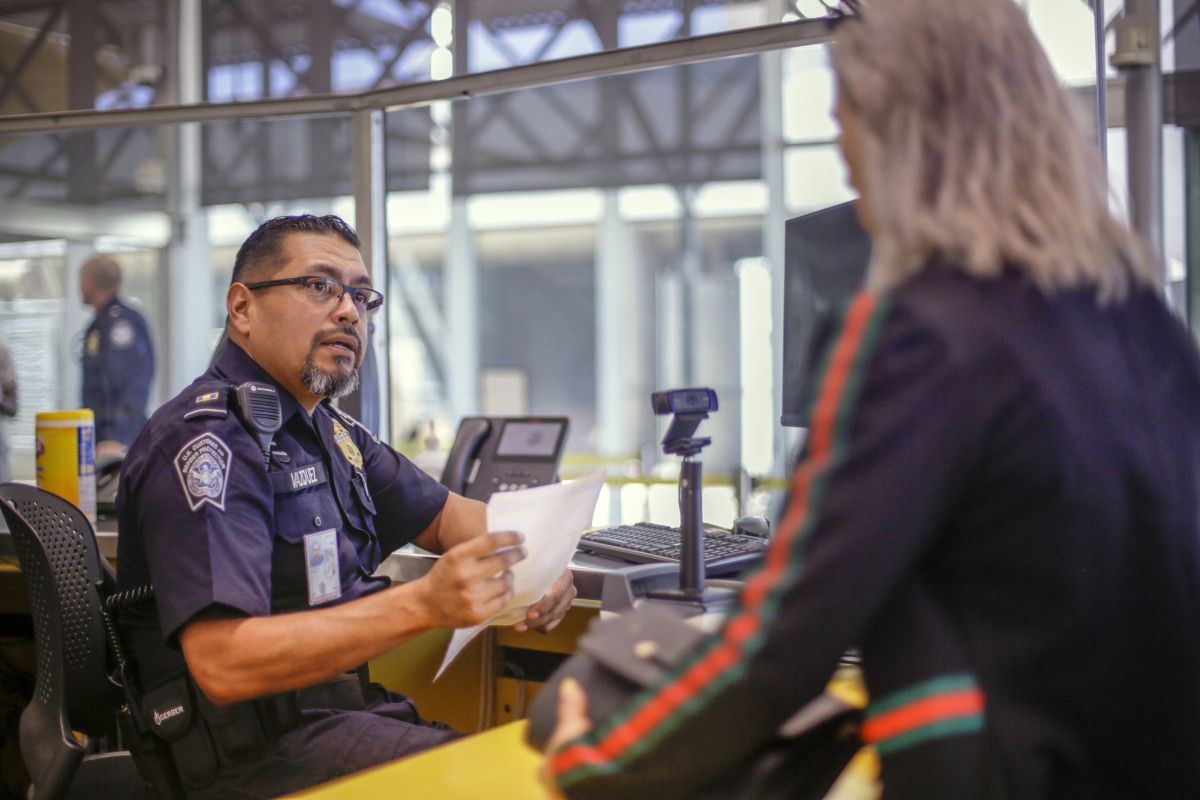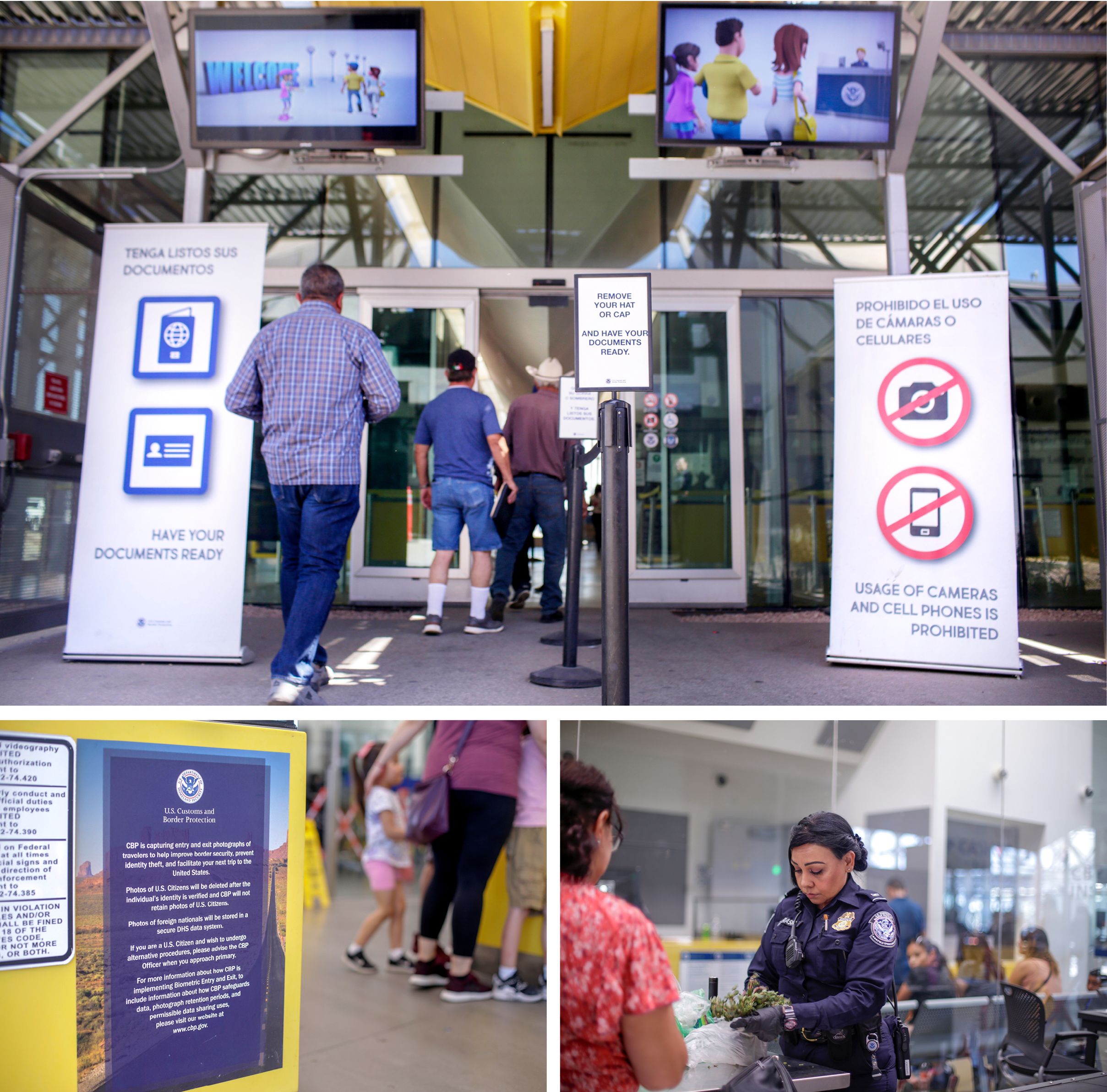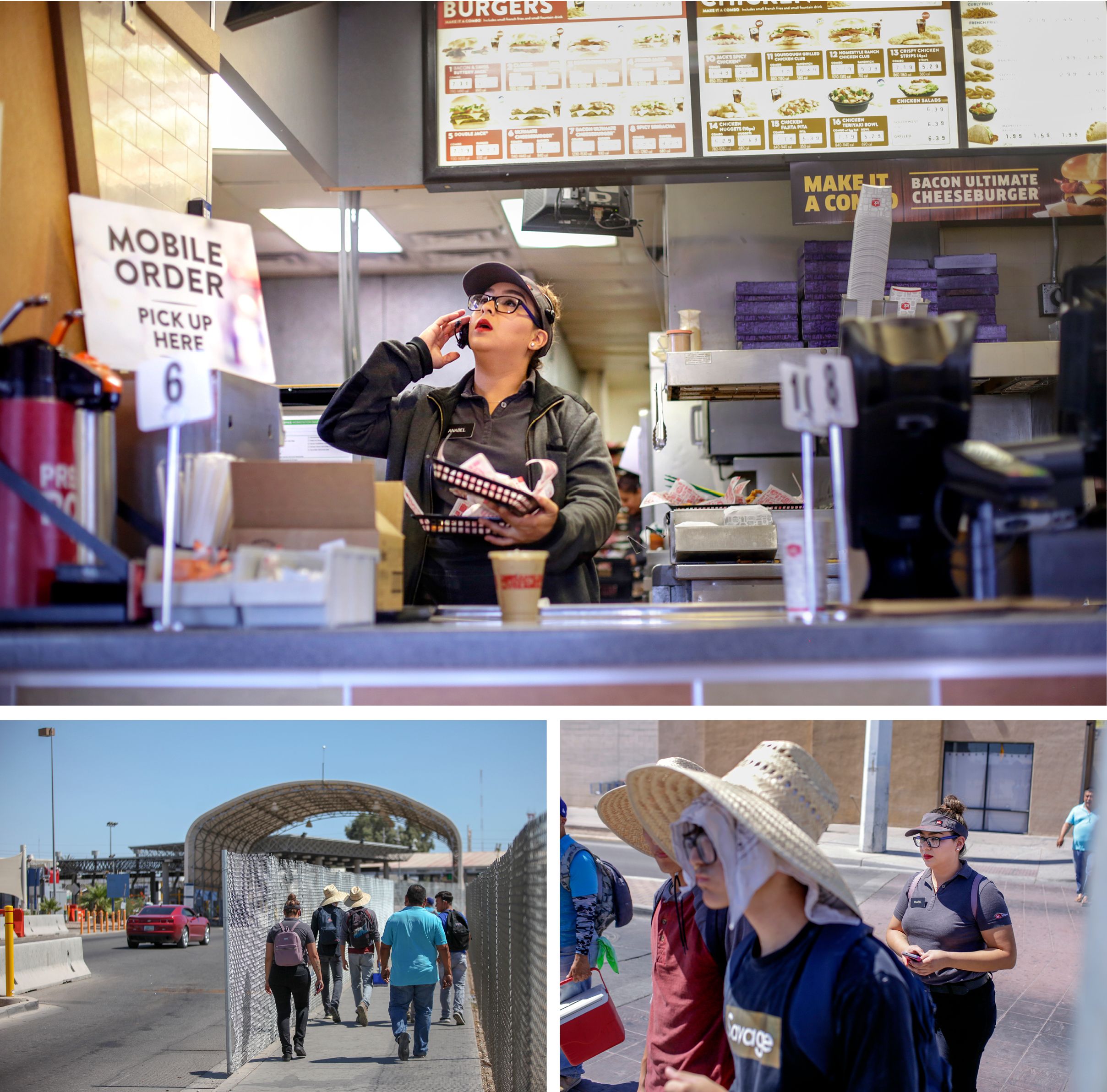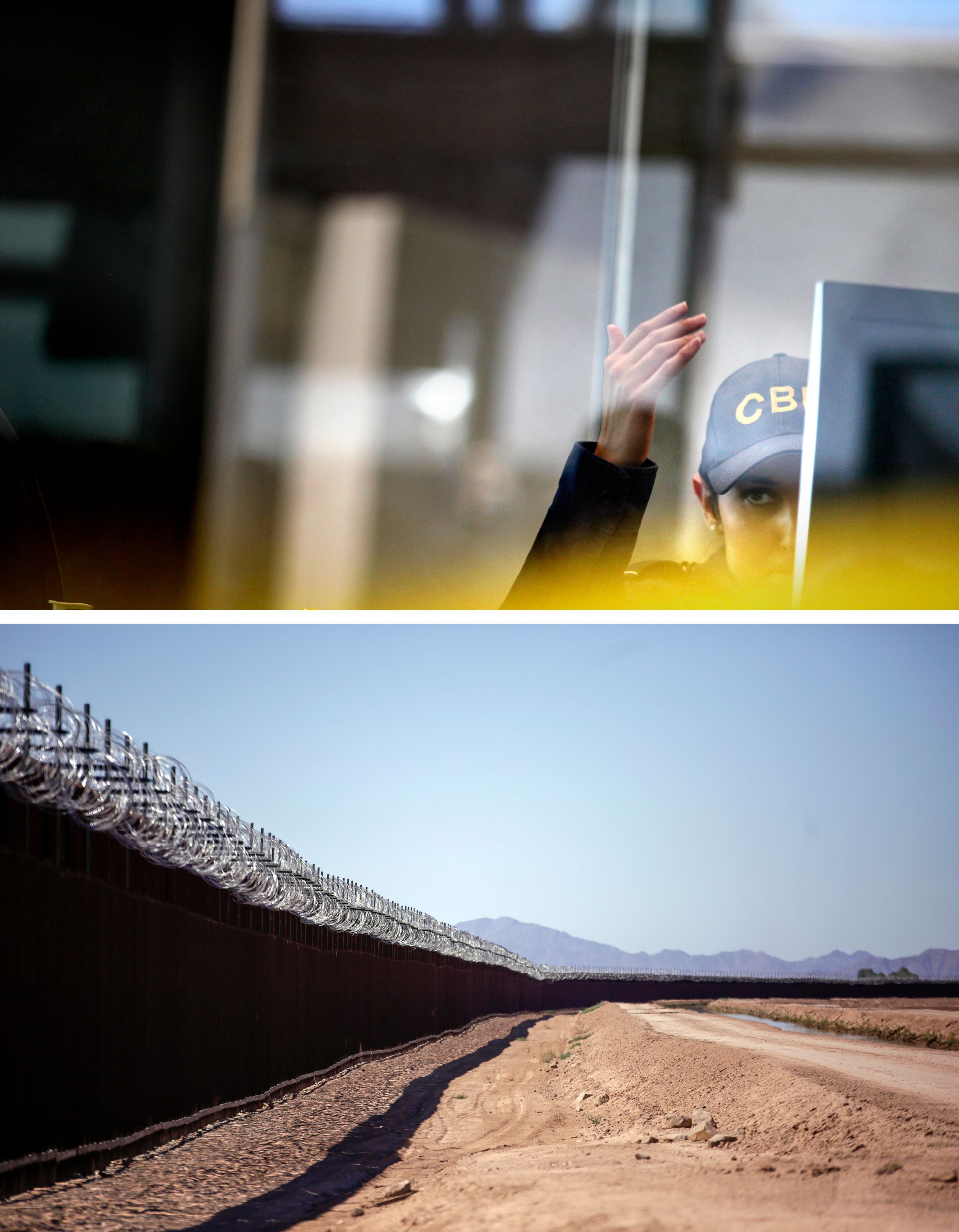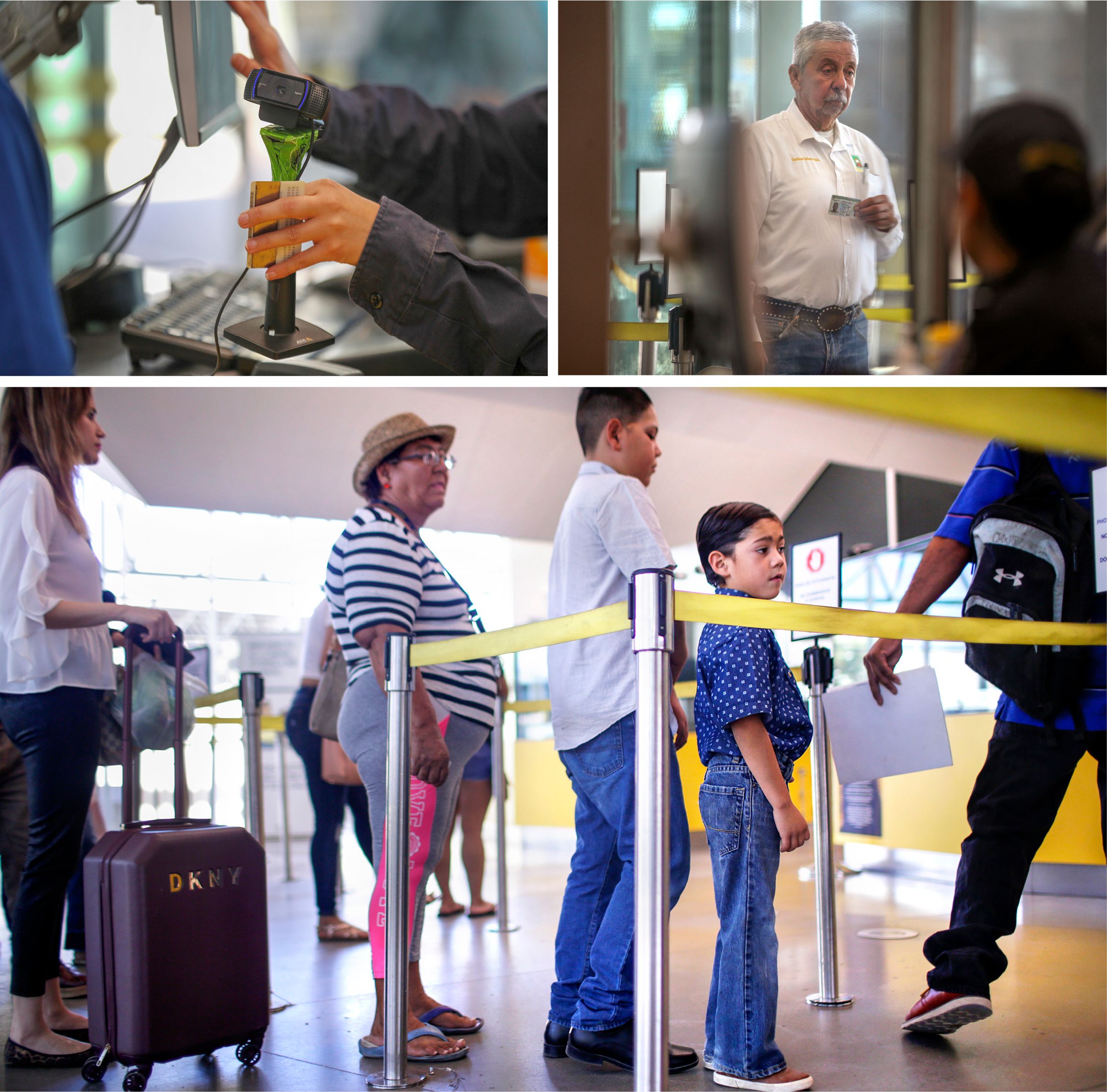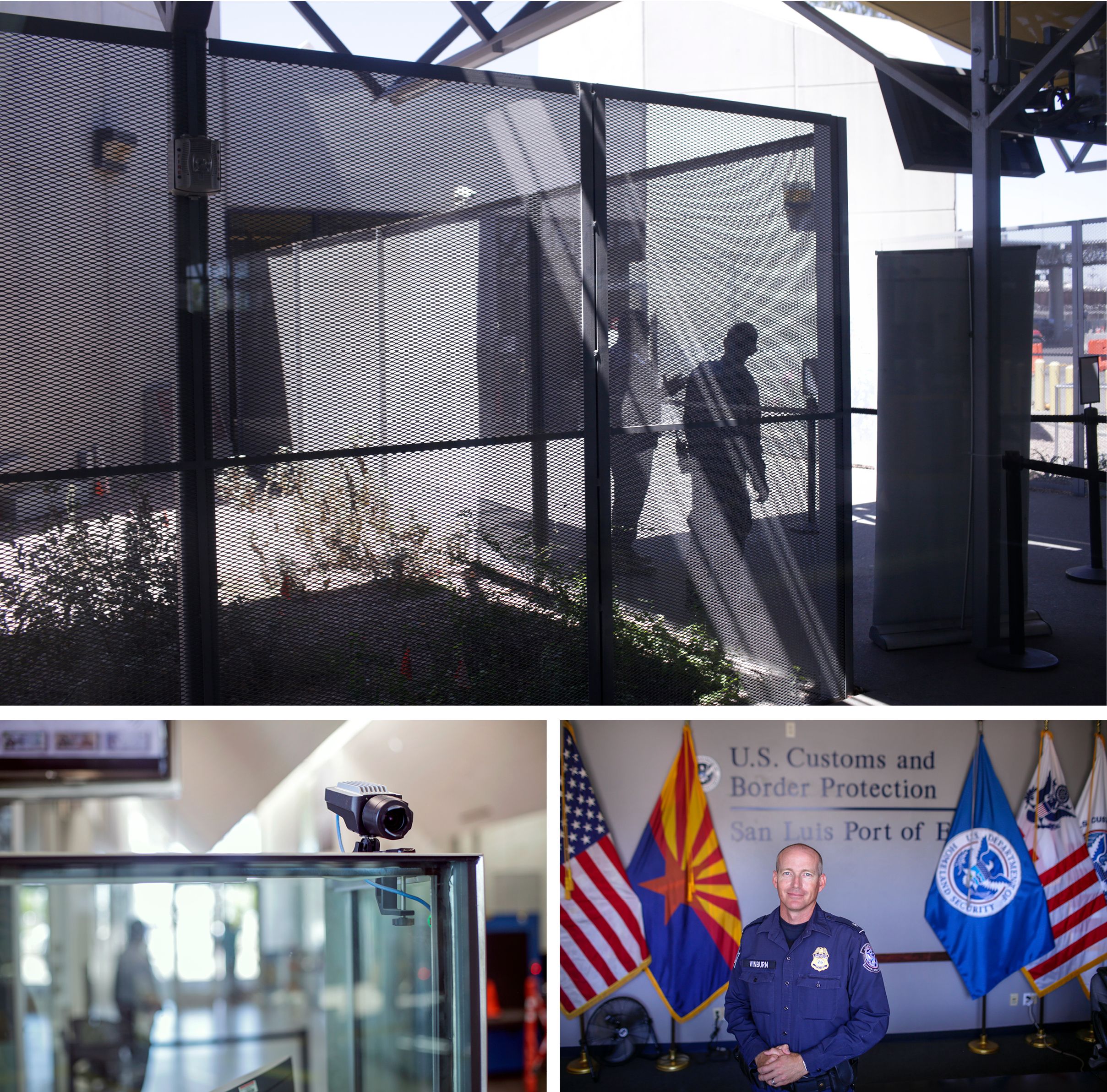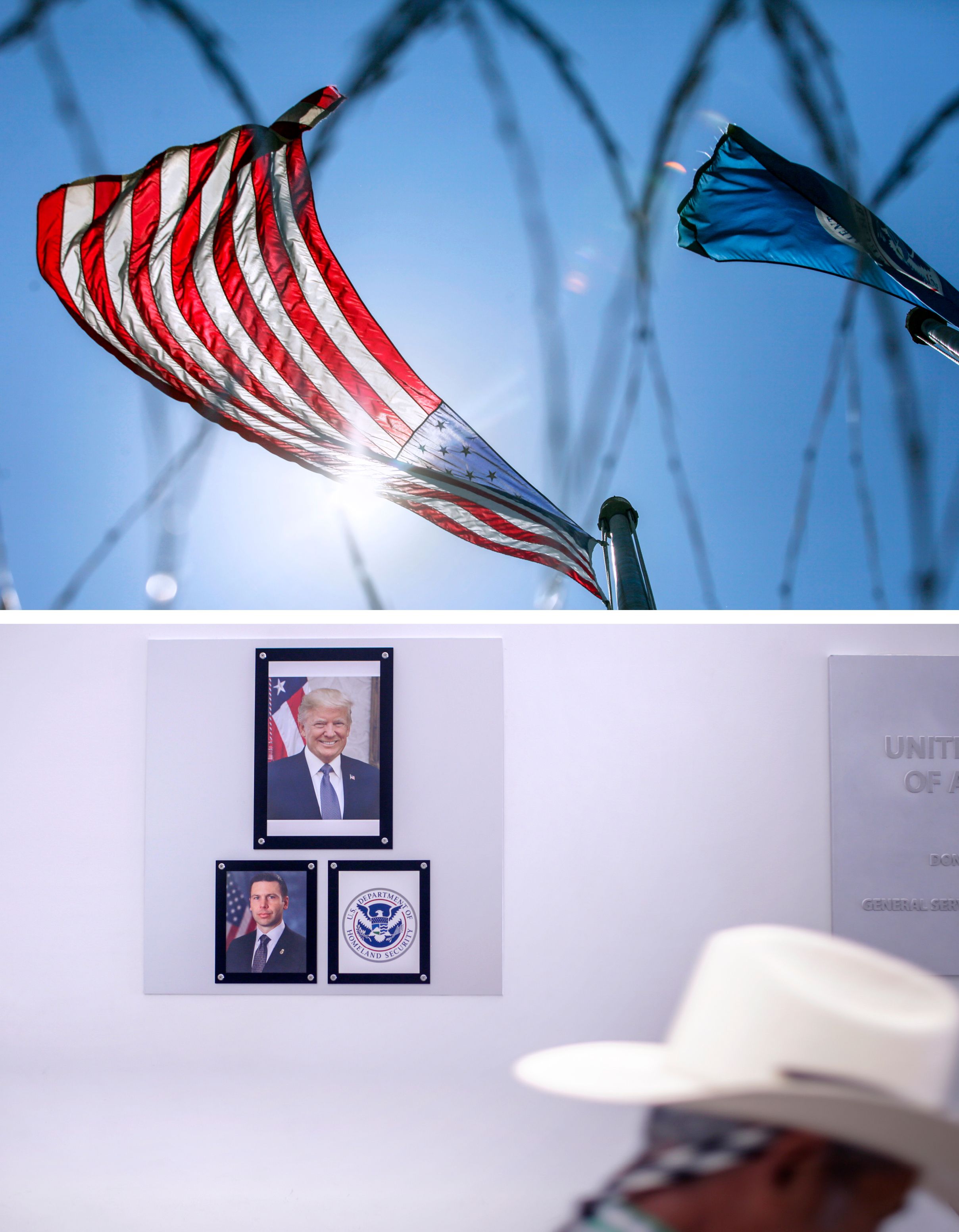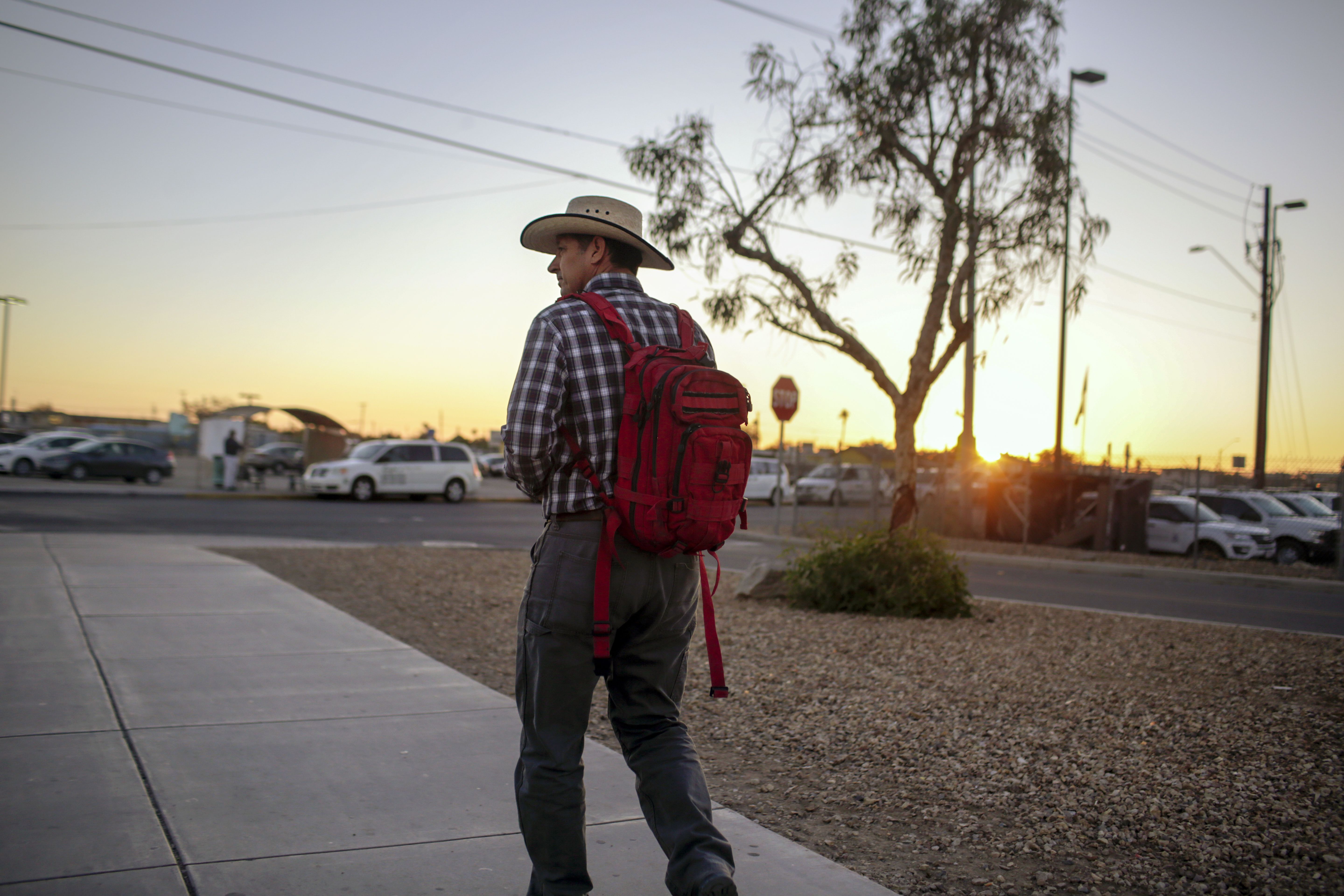SAN LUIS, Ariz. – By the time the sun rises, there’s already a line of people waiting to cross into the United States. They stand near a smattering of small buildings that make up the port of entry separating two border towns named San Luis, one in the United States, the other in Mexico. Anabel Castorena, who has been here since 5:40 a.m., walks through the glass doors of the building where agents inspect people crossing the border by foot.
Nearly every day, the 28-year-old U.S. citizen and mother of four makes this trek from her house on the Mexican side to her job on the U.S. side. Today she’s wearing the dark gray polo shirt provided by the nearby Jack in the Box drive-in where she works. Her hair is pulled up into a tight bun that emphasizes her soft features.
The hairstyle also makes it easier for Customs agents to capture a clear image of her face.
It’s been a few months since Customs set up the facial recognition cameras that have become part of her daily routine. “It started when they opened this new building,” Castorena says, with a shrug. Customs and Border Protection has been scanning the faces of every one of the more than 200,000 people who cross the border by foot here, one of its busiest land crossings, each month. The agency is adapting facial recognition technology first used at airports to two land crossings in Arizona – San Luis and Nogales – as part of a pilot program set to conclude this month.
Setting up a land border program is a bit more challenging because, unlike at airports, Customs agents don’t get advanced notice of who is arriving and departing. But if all goes well with the pilot, CBP plans to begin using facial recognition at other land crossings.
The goal of the program in San Luis is to test whether it’s possible to police America’s borders and airports with technology that’s better than humans at verifying identification. If it works, it could make crossing into and out of the United States easier and faster and give CBP a powerful new tool to identify the small minority of border crossers who pose a security threat.
But not everyone is convinced that facial recognition technology is ready for the real world. The concerns fall into two buckets: First, that the technology just doesn’t work very well, that it makes mistakes particularly when trying to read black and brown faces. And second, that facial recognition poses a real privacy threat because the government could track people without their knowledge or develop portfolios of photographs of citizens — something that would go far beyond the occasional driver’s license or passport photo the government currently keeps on file.
The American Civil Liberties Union has been especially critical of what it calls “advanced tracking and surveillance technologies” that use biometrics like faces and fingerprints and has suggested they could be used for monitoring and controlling the U.S. population the way China already uses biometrics to keep an eye on its citizens.
But in San Luis, CBP isn’t waiting for these questions to be answered. Instead, they are focused on making the technology work at a busy land border.
The large open space of the new processing center resembles the Customs inspection area at an airport, but the technology is different. There aren’t any kiosks for travelers to stop and pose in front of while a camera snaps their picture. In San Luis, small cameras sit atop the glass partitions that wrap around each officer’s station, separating them from the masses. These cameras capture images in motion, as each person walks up. It’s over in a matter of seconds—unless the quality of the photo is too poor. In that case the agent may take another picture manually with one of the small portable cameras kept at their desks.
The photo of Castorena confirms her identity, and she’s allowed to leave. She exits the building slowly, checking her phone as she follows the cluster of people walking out with backpacks, bags of food and other small items necessary for the day ahead of them. Within an hour, Castorena is greeting drive-in customers through a headset and filling orders for breakfast sandwiches and burritos.
What happens next to her photo is the subject of debate.
In response to complaints by privacy advocates, CBP pledged to delete photos it captures of U.S. citizens like Castorena at land, sea and airports within 12 hours of confirming their identities. The rules for non-citizens are different; the agency holds on to their photos for up to 14 days before transferring them to a database managed by the Department of Homeland Security’s biometric office. They’ll be stored there for 75 years, long enough to last most visitors’ lifetimes and provide U.S. security services a new tool to help verify that visitors aren‘t entering with stolen documents or identities.
That kind of long-term storage has some lawmakers on Capitol Hill worried about whether CBP has adequate safeguards in place to protect its database from being hacked – concerns that were only amplified after a recent data breach that exposed thousands of traveler images collected by a CBP subcontractor.
Because its mission includes preventing foreign criminals and terrorists from entering the country, CBP has an unusual status in the American legal system and that means it has been exempted from many of the rules designed to control the use of facial recognition. New rules that govern law enforcement, for instance, don’t include the CBP, and San Francisco’s recently enacted ban on facial recognition includes a carveout to let the CBP use the technology at its airport.
But in recent months, several Democrats have accused federal agencies of working behind lawmakers’ backs to expand their use of facial recognition on U.S. citizens; for instance, U.S. Immigration and Customs Enforcement and the FBI have acknowledged scanning faces in state driver’s licenses databases to search for criminals and illegal immigrants.
Talks in the House have turned to enacting a “moratorium” on federal use of facial recognition until new standards are set. But Hill staffers say that CBP might not be included in any action taken. In fact, any federal rules to restrict the use of facial recognition for homeland security purposes might still be some time in the future — if ever.
In the meantime, the realities of the San Luis crossing demonstrate just how embedded the technology has already become in U.S. security procedures, and how hard it is to opt out of even an optional scan.
THE RATIONALE DRIVING the development of facial recognition technology is the idea that humans aren’t as good as you might think at identifying faces. Benji Hutchinson, vice president of federal operations at NEC Corp. of America, which manufacturers biometric equipment, said that most people can only match a photo to a stranger in a lineup about 50 percent of the time; the success rate is about 70 percent if the person is an acquaintance. So if facial recognition technology is accurate 96 percent to 99 percent of the time, that’s a big improvement.
“If you can get to that level of probability and assurance, why wouldn’t you want to do it?” Hutchinson said. “They’re taking a photo that you gave them for your visa or passport and they’re just comparing it more quickly to the image they’ve taken of you standing in front of them. It’s much more accurate. It’s much quicker.”
And afterward, he said, “they destroy that image.”
But not everyone is so sanguine about the technology, particularly at the state level. For instance, California has been enacting restrictions on police and local agencies’ use of face scans based on the belief that the technology is inaccurate.
Shortly before California state lawmakers banned police from using facial recognition tools on bodycam footage in September, the American Civil Liberties Union of Northern California released findings from its test of Amazon’s “Rekognition” facial recognition software, which it said falsely matched the images of 26 California state lawmakers to mugshots in a public database. It wasn’t the first time the group publicly questioned the effectiveness of face-scan software. The ACLU did a similar experiment with Amazon’s software in 2018, comparing photo database of mugshots of people arrested for crimes with members of Congress and found the software incorrectly matched 28 lawmakers with mugshots. Eleven were lawmakers of color.
Amazon called the latest ACLU test misleading because the group used the default confidence threshold in the face-matching software; the company said it recommends law enforcement agencies set the threshold at 99 on a 100-point scale, meaning the system will return matches only when the system is at least 99 percent certain of accuracy. ACLU’s test used a minimum confidence threshold of 80 percent.
Some in the industry, like Hutchinson, say they would support legislation that takes a moderate position on how the technology can be used; for instance, NEC would back a ban on using facial recognition for “political or prejudicial purposes.” Hutchinson suggested an unbiased third-party testing agency like National Institute of Standards and Technology should develop standards for testing photo databases, including rules for diversifying the photo databases so that discrimination is less likely to occur.
“If there’s going to be legislation, let’s make it balanced,” Hutchinson said.
NIST is currently drafting a report on how facial recognition algorithms work in terms of identifying people of various ages, genders and races. It is slated to be released this fall, an agency spokesperson said.
As standard-setting begins at the federal level, Hutchinson said he hopes the public conversation expands to include research that shows the effectiveness of the technology, not just findings of discrimination and matching inaccuracies: “The discussion that needs to be had is that some of those research findings are old, they’re out of date. There are new ones that have come around and they’re better. And they show that there’s been exponential improvements.”
CBP declined to say whose software it uses at the San Luis port. But there are a variety of tech companies currently seeking to dominate the facial recognition tech market -- including Microsoft and Apple – and hoping to land government contracts. As one of the earliest and fastest adopters of biometrics technology, CBP is certainly at the top of lists for potential agency partners.
CBP first launched a screening program to collect biometric data from foreign nationals in 2004. But in 2013, Congress made CBP responsible for collecting data from travelers exiting the U.S. That’s when the agency first began considering a switch from fingerprint scanners to facial recognition, said Dan Tanciar, CBP’s deputy executive director of planning, program analysis and evaluation for the entry/exit program.
“Frankly, it takes a little time to collect fingerprints,” he said. “And when you’re dealing with something as sensitive as aircraft boarding time and aircraft departure time, we wanted to sort of find something that would be more conducive to that departure environment.”
Any foreign national between the ages of 14 and 79 is required to provide biometric data upon arrival, with a few exceptions: Diplomats aren’t required to provide biometrics, and neither are Canadians because the law permits them to enter the country without visas. U.S. citizens also have the right to opt out of having their photo taken and request a manual inspection of their passport and documents instead, Tanciar said.
Yet, at the border, many citizens say Customs agents don’t give them options. POLITICO interviewed more than a dozen people as they exited the port of San Luis and received a mix of responses to questions about their understanding of the facial recognition process.
Christian De La Hoya, a 42-year-old vegetable packer who lives in San Luis, Ariz., says he doesn’t feel like he has much of a choice. He goes to visit family in the other San Luis at least once a week and is resigned to having his photo taken because he doesn’t think it’s worthwhile to push back or ask questions when he’s that close to crossing over, especially if it’s a hot day and the line is long. “I just want to cross,” he said. “I’m like, ‘Just hurry up and take my picture.’ Most people are annoyed after standing in the sun. They just want to cross.”
But he said he does wonder what the photos are being used for. “Well, it’s the government,” he said. “You don’t know what they’re doing with them. You have to trust them.”
Talitha Mathis, 38, lives in Portland, Ore., but was visiting the area and decided to visit Mexico with her family and childhood best friend. She said she got flippant reactions when she asked agents why they were taking photos of her and her husband without consent. “They didn’t give us an answer,” she said. “I just want to know why you’re taking my picture.”
Locals in Nogales, Ariz. also were initially very confused by the cameras, according to Joanna Williams, who works for the Kino Border Initiative, a faith-based advocacy group for immigrants crossing the U.S.-Mexico border. She said many locals were worried by the timing; the cameras were installed in late 2018 around the same time President Donald Trump began raising the alarm about a caravan of migrants from Central America that he claimed was funded by Democrats and might include “criminals and unknown Middle Easterners.”
Williams said people in the Nogales community were concerned because they “didn’t have information on why the cameras were in use, where the photos went and why they were installed at that particular time.”
She said CBP agents eventually put up basic signs with information about the pilot project, but many people still have questions about what CBP means when it tells border crossers that it will hold on to foreign nationals’ photo for future use.
When asked to comment, Justin Winburn, a spokesman for CBP at the port of San Luis, points to the signs posted around the building in English and Spanish notifying people that cameras are in use as an additional border security measure. Photos of U.S. citizens will be deleted “after the individual’s identity is verified and CBP will not retain photos of U.S. citizens,” the sign reads.
He acknowledges that occasionally someone will refuse to have their picture taken, and that’s fine if they’re a U.S. citizen. In those cases, agents will revert to the standard inspection process. But mostly “people, they really don’t mind,” he said.
It’s possible that people don’t put up a fight because they expect to be subject to invasive searches and lengthy questioning when they enter the country. And there is good reason for that, according to Jonathan Meyer, a former deputy general counsel at DHS.
Meyer said there is a long-standing U.S. legal concept known as border search authority that essentially creates an exception to the Fourth Amendment protections and that allows CBP and other authorities to conduct searches more easily at the border.
“It’s quite well-established in law and that’s what CBP uses to ask people questions when they’re coming into the country, sometimes take them into secondary inspection, sometimes search people for illegal goods – all that is under border search authority,” he said. Meyer, who is now a partner at law firm Sheppard Mullin, said the border search authority applies to physical borders as well as “functional borders” like airports that serve as initial entry points to the U.S.
However, the parameters of border search authority aren’t completely clear, particularly when it comes to developing technology like cellphones and facial recognition, Meyer said, adding that there are “degrees and levels of what’s permitted.”
“For example, a physical search is going to be treated very differently than asking a person questions because it’s more intrusive,” he said. “And, so, where on the spectrum of intrusiveness facial recognition lies, I think is still somewhat a question.”
Meyer said it’s expected that CBP, like any agency, would advocate for as much authority as it thinks it needs through an aggressive interpretation of the law and for advocacy groups to take the opposite interpretation. Ultimately, he said, the limits on use of facial recognition will likely be set the same way they were for an earlier new technology – cellphones. It’s been the courts who’ve decided the proper parameters for searching cellphones, and they will likely be the means of establishing rules limiting use of facial recognition.
FEDERAL AGENCIES ARE already finding that they need to work harder to convince the public about the merits of using facial recognition and the technology as citizens become more aware of how it is creeping into multiple facets of their daily lives.
The Brookings Institution conducted an online poll of 2,000 people last year and found that 44 percent opposed using the software in airports and stadiums. And 50 percent did not like the idea of it being used in retail stores to prevent theft.
“In general, people are skeptical about facial recognition software,” said Darrell West, Brookings’ vice president of governance studies and founding director of its Center for Technology Innovation. “They worry about an invasion of privacy,” he added. “They wonder how the information is going to be used.”
He said that people seem to value their faces more than say fingerprints because they fear the images could more easily be used against them by the government or by other parties on social media. Privacy advocates also have said they worry that the technology is being used to create surveillance systems without the knowledge or consent of the American public.
Jeramie Scott, senior counsel and director of the Domestic Surveillance Project at the Electronic Privacy Information Center, said the group is opposed to government use of facial recognition “against a background that lacks any real federal regulation” and when “there’s been a lack of public involvement and debate about its use.”
He said the center is concerned there might be “serious privacy issues and risks” associated with CBP’s facial recognition use, including that the agency is using passport photos submitted to the State Department to create a gallery of photos to which facial scans can be compared.
EPIC filed a lawsuit in the U.S. District Court for the District of Columbia in 2017 against CBP after it said the agency failed to comply with Freedom of Information Act requests for documents related to CBP’s use of facial recognition.
Scott called DHS’s use of passport photos for various facial recognition projects — including those at CBP, TSA, ICE and the Coast Guard – an example of “mission creep” that violates the spirit of the Privacy Act that established federal fair practices for the collection and dissemination of personally identifiable information.
“This is not something I would think most people signed up for or even knew was a possibility when they were getting their passport,” he said. Additionally, he said he was skeptical of the trials being run at the southern border after reading a report EPIC received through an FOIA request that showed an earlier 2015 field test at a border crossing in Otay Mesa, Calif., faced challenges when using facial and iris scanners on pedestrians.
However, CBP notes in the report that Otay Mesa was an “experiment of experiments” that used noncustomized commercial off-the-shelf technologies and was meant to help the agency “determine the feasibility and usability of potential deployable biometrics solutions in an outdoor environment.”
And a CBP spokesperson said the field test was “very different to what is going on now in Arizona.”
Facial recognition pilots at the southern border predate Trump, though they have increased since he took office in 2016. CBP said it processed more than 8.3 million travelers using facial recognition last year.
Trump, who has been laser-focused on cracking down on illegal immigration at the Mexican border, issued an executive order in 2017 requiring CBP to quickly complete the entry-exit system. The following year, CBP established two pilots in San Luis and Nogales and another at a motorist crossing at the Anzalduas, Texas, port. The Anzalduas pilot ended earlier this year, according to CBP officials. License plate images and traveler ID photos collected at that port were later stolen from a subcontractor.
Facial recognition also is facing a backlash among some policymakers who have raised privacy concerns and questions about the accuracy of the technology.
Members of the House, in particular, seem alarmed by reports that facial recognition is less accurate when used on darker-skinned faces. It’s become a particular concern for Rep. Alexandria Ocasio-Cortez and other women of color in what has colloquially become known as “the squad” — a group of women lawmakers that also includes Reps. Rashida Tlaib (D-Mich.), Ayanna Pressley (D-Mass.) and Ilhan Omar (D-Minn.). Tlaib and Pressley along with Rep. Yvette Clarke (D-N.Y.) recently introduced a bill that would ban the use of facial recognition in federally funded public housing as some landlords consider using it for secure entry systems.
“Vulnerable communities are constantly being policed, profiled, and punished, and facial recognition will only make it worse,” Pressley said in a statement.
Leaders of the Oversight Committee recently held hearings on the technology and are drafting legislation that would suspend government funding for any new or expanded use of facial recognition.
The committee’s top Republican, Rep. Jim Jordan of Ohio, has said that members of the panel are discussing restricting existing uses of the technology at federal agencies, though Hill staffers have said current CBP activities might be omitted from the legislation.
It’s a potentially sticky legislative situation for lawmakers given that, unlike most agencies, Congress gave CBP explicit authority to use facial recognition. Lawmakers just didn’t think it would use the technology on U.S. citizens. Technically, the entry/exit tracking systems was supposed to include only foreigners, said House Homeland Security Chairman Bennie Thompson (D-Miss.), who stopped short of saying the agency should stop using the technology on U. S. citizens.
“No, I just think the agency needs to be a little more forthright in its approach to looking at technology and not just kind of let it creep in,” he said following the committee’s hearing on DHS use of facial recognition. “You know, if you think that’s a good way of keeping us safe then we ought to do it. But it should have congressional authority.”
On the Senate side, the bipartisan duo of Mike Lee (R-Utah) and Ed Markey (D-Mass.) have called for DHS to “pause” its use of facial recognition until it establishes formal rules on privacy and data protections.
Meyer said the back-and-forth on the Hill is somewhat confusing given Congress was pushing CBP to speed up its facial recognition use a little under a decade ago.
“CBP has a mandate from Congress to develop a biometric exit/entry program,” he said. “Congress was always on us about it because it felt DHS wasn’t moving quickly enough to implement the technology.”
“It turned out,” he said, “to be a pretty difficult thing to do.”
